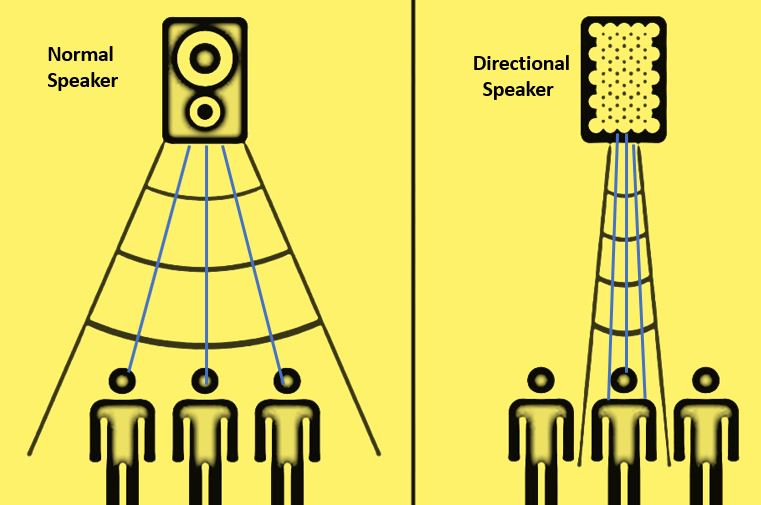Directional speakers emit sound in a focused direction, similar to a spotlight, unlike conventional speakers that spread sound in all directions.
This makes them useful in maintaining privacy in public places, enhancing commuter safety, and promoting hygiene in busy areas.
Did you know that directional speakers can enhance the engagement and profitability of your showroom? You may be wondering how these speakers emit directional sounds and how they differ from conventional ones. Let’s explore these questions together.
Directional Speakers Vs. Conventional Speakers

Directional speakers differ from conventional speakers in the way they emit sound. While conventional speakers broadcast sound in a wider spread, directional speakers emit sound waves in a focused direction. This means that each speaker emits unique sound waves. Traditional speakers emit sound waves in all directions, while directional speakers emit high-frequency sound waves.
Directional or focused speakers emit sound only in one direction. They are highly suitable for public places like railway stations (where safety is important), hospitals, stores, museums, and galleries (where specific sounds are needed). If you’re looking to advertise your retail stores, galleries, or museums or target a specific audience, Focusonics directional speakers can be a great solution for your needs since they provide precise and stable directional audio.
How do conventional speakers operate?
To grasp how directional speakers work, it’s important to first understand how conventional speakers function. A basic speaker consists of two sides – one with a thin plastic disc and a large magnet, while the other side features an electromagnet that can be charged or discharged through electricity. A plastic disc is placed between two magnets and is pulled or pushed when the electromagnet is charged or discharged. The disc vibrates back and forth, causing the air in front of it to also move back and forth. This creates sound waves that travel out in all directions.
How do directional speakers operate?
Directional speakers work by emitting high-frequency ultrasound that is beyond the range of human hearing. These speakers emit a narrow beam of sound due to the shorter wavelengths of the ultrasound. However, despite emitting ultrasound, humans can’t hear the sound produced by these speakers. Directional speakers emit ultrasonic beams that cause sound to become deformed as it travels through the air. As a result, a low-frequency directional audio beam is generated, which is audible to us.
Enhance your museum visitor experience with directional speakers

Museums can enhance their exhibitions by using directional speakers. Visitors come to museums to learn and enjoy themselves, but distractions, ambient noise, and uninteresting exhibits can detract from their experience. This can lead to dissatisfaction and discourage visitors from recommending the museum to others. Using directional speakers can help solve this problem.
When visiting museums and galleries, paying attention is crucial. To help visitors focus, highly directional speakers are a great option. This guide provides information on the benefits, use cases, examples, and installation advice for directional speakers in museums. If you’re a gallery manager or museum curator looking to improve your space’s accessibility and excitement, we have the solution for you.
Visitor expectations in the museum
Recall the time when you visited a history museum during your school days. You may remember walking through silent, enclosed rooms, observing historical objects, and reading information signs. Despite the fascinating stories that were told, which were filled with conflicts, drama, and heroism, the experience may not have been very captivating.
Museums have significantly improved the appeal of their exhibitions in recent times by incorporating interactive displays and innovative experience design to captivate their audience. However, it is crucial to strike a balance between these modern features and the traditional, thoughtful experience that art museums and galleries offer. Overdoing it with excessive lights, screens, and loudspeakers may not be enjoyable for everyone. AR and VR exhibits are exciting, but they can be disorienting, nauseating, and raise hygiene concerns when shared between users. To address these issues, directional speakers are a helpful solution.
How to transform your museum or gallery space with directional speakers?

Provide sound for your displays
Typically, when visiting galleries and museums, the audio content is focused on specific exhibits such as paintings, screens, artifacts, and other displays. Directional audio technology is ideal for this purpose, as it projects sound only when a person is in front of the exhibit. This can include ambient music, spoken-word descriptions, or other audio enhancements, which add an extra dimension to the museum experience.
Eliminate the need for fixed headphones
In public spaces where hygiene is crucial, minimizing physical contact can be beneficial. For instance, instead of offering headphones that are shared by multiple individuals daily, a directional speaker above an exhibit can be a more elegant solution. Not only does this reduce the risk of spreading germs, but it also minimizes wear and tear on headphones that are frequently used and need repair or replacement. With a directional speaker setup, there is no need for physical contact, resulting in less maintenance.
Preserve calm and reduce sound pollution
When people visit your space, it’s important to provide a peaceful and quiet environment to help them clear their minds and focus. If you have multiple exhibitions with sound playing simultaneously, it can create a noisy atmosphere. This can be distracting and make it difficult to concentrate. To solve this issue, you can use directional speakers that project high-quality audio in a narrow beam. This way, only the intended listener can hear the sound. Using this solution, you can have multiple sources of audio playing in the same space while maintaining a sense of calm and tranquility.
Improve accessibility for all
Ensuring that everyone can enjoy your museum experience is crucial, regardless of their physical abilities. While sound systems enhance the auditory experience of museum displays, it’s also important to consider logistics. Visitors with visual impairments may struggle to navigate the different areas of the museum without clear signage. To address this, directional speakers can be placed in key areas like entrances, exits, and pathways, informing visitors of the area they are about to enter.
Explore new creative opportunities
In the Hèrmes case study, there are various ways to amaze and fascinate guests with creative exhibits. When sound can be directed to an individual, the potential for engaging interactive art is vast. People can use a beam of light to activate a sound, play musical notes with their movements, or encounter various sensory experiences by observing an artwork from different perspectives within the surrounding space.
Related Posts:
- 20 Best Gaming Headset Under 50$ 2024 - for PC, PS4,…
- 12 Best Car Wax For Black Cars 2024 - Protection and…
- 15 Best Dog Food For Allergies 2024 - Adult, Puppy…
- 15 Best Shoes for Jumping Rope 2024 - Maintain a…
- Top 10 Best Outdoor Basketball Shoes 2024 - Durable…
- 10 Best Climbing Harness of all Time 2024 - Opinion…







